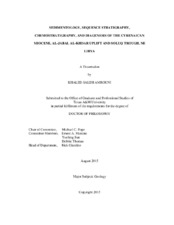| dc.contributor.advisor | Pope, Michael C | |
| dc.creator | Amrouni, Khaled Saleh | |
| dc.date.accessioned | 2015-10-29T19:59:05Z | |
| dc.date.available | 2017-08-01T05:37:33Z | |
| dc.date.created | 2015-08 | |
| dc.date.issued | 2015-08-11 | |
| dc.date.submitted | August 2015 | |
| dc.identifier.uri | https://hdl.handle.net/1969.1/155704 | |
| dc.description.abstract | This study established the sequence stratigraphic framework of the Cyrenaican Miocene through the integration of the sedimentology, stratigraphy, gamma-ray logs, chemostratigraphy, and diagenesis. Carbon-isotope curves and gamma-ray logs with sedimentologically described measured stratigraphic rock sections of the Ar-Rajmah Group were implemented to define facies depositional models and their sequence stratigraphic patterns within a high resolution timeframe.
The Ar-Rajmah Group of the Cyrenaican Miocene includes the Benghazi Formation and Wadi-al-Qattarah in the Al-Jabal al-Khdar north, and its equivalent Msus and Sceleidima formations in the Soluq Trough south. The Cyrenaican Miocene is made up of two 2nd-oreder sequences (SS1-SS2) that includes six 3rd-order sequences (S1-S6), and at least 20 parasequences.
The 3rd-order sequences S1 and S2 represent the Early Miocene and are dominated by open marine bioclastic packstone and red algal packstone facies. The Early Miocene SS1 is separated from the Middle and Late Miocene SS2 by a major unconformity surface. The Middle Miocene is represented by the 3rd-order sequence S3 that dominated a mixture of oolitic grainstone, microbialites, and bioclastic packstone, red algal packstone, with evaPorites, sandstone and green shale. The 3rd-order sequences S4-S6 represent that Late Miocene sequences and dominated by oolitic grainstone, microbialites, with evaPorites and some bioclastic packstone and red algal packstone facies.
The correlation between the Cyrenaican stratigraphic record and the regional Mediterranean and global Miocene isotope records, and global sea level curve indicates that the 3rd-order depositional sequences of the Cyrenaican platform were affected by a tectonic signature besides the eustatic sea level fluctuations. The Cyrenaican Miocene sea level curve does not show a great similarity with the global sea level curve due to the tectonic influence.
Microscopic analysis, stable isotope data, and trace elements were implemented to define the diagenetic events. Cross-cutting relationships were applied to define the paragenetic sequence of the diagenetic events within the stratigraphic framework of the Cyrenaican Miocene succession. The Ar-Rajmah Group carbonate rocks were affected by 18 diagenetic events caused by six diagenetic processes including the meteoric water diagenesis. | en |
| dc.format.mimetype | application/pdf | |
| dc.language.iso | en | |
| dc.subject | Cyrenaica Miocene Sequence Stratigraphy Wadi Al-Qattarah Formation Ar-Rajmah Group Benghazi Formation Chemostratigraphy Stable Isotopes Diagenesis | en |
| dc.title | Sedimentology, Sequence Stratigraphy, Chemostratigraphy, and Diagenesis of the Cyrenaican Miocene, Al-Jabal Al-Khdar Uplift and Soluq Trough, Ne Libya | en |
| dc.type | Thesis | en |
| thesis.degree.department | Geology and Geophysics | en |
| thesis.degree.discipline | Geology | en |
| thesis.degree.grantor | Texas A & M University | en |
| thesis.degree.name | Doctor of Philosophy | en |
| thesis.degree.level | Doctoral | en |
| dc.contributor.committeeMember | Mancini, Ernest A | |
| dc.contributor.committeeMember | Sun, Yuefeng | |
| dc.contributor.committeeMember | Thomas, Debbie | |
| dc.type.material | text | en |
| dc.date.updated | 2015-10-29T19:59:05Z | |
| local.embargo.terms | 2017-08-01 | |
| local.etdauthor.orcid | 0000-0003-3699-0299 | |


